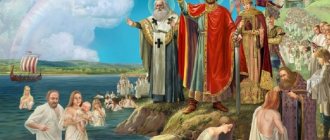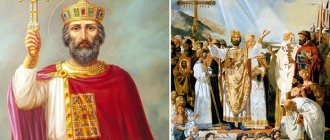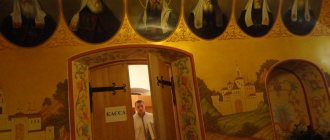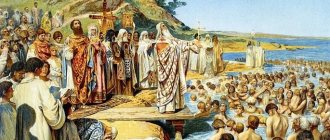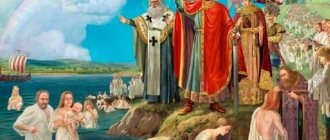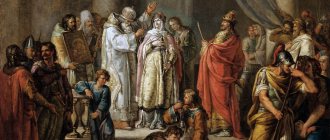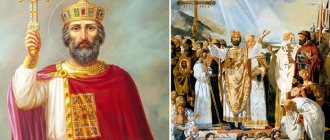- August 11, 2019
- Events
- Olga Strelkova
From the point of view of modern historians, the essence of the baptism of Rus' by Prince Vladimir is the introduction of Christianity into Kievan Rus as the state religion. According to tradition, according to chronicle chronology, this event dates back to 988. This date is also considered as the beginning of the official history of the Church in Russia. However, the question of what century the baptism of Rus' dates back to and to what year is currently debatable. Along with the above, other dates are also named. The history of the baptism of Rus' will be briefly discussed in the article.
Background to the adoption of Christianity in Kievan Rus
Before we begin to describe the procedure for the baptism of Rus' by Vladimir, we should understand the background, prerequisites and reasons for this process.
For Byzantium, conversion to Christianity in relations with warlike peoples who professed paganism was a common practice. In the 9th century there were attempts to Christianize Moravia (in 862) and Bulgaria (in 864-920). Through the baptism of the ruling circles, Byzantium tried to strengthen its influence on pagan countries, thereby reducing the danger of military action on its own borders.
After the Rus attacked Constantinople in 860, similar tactics were used against Kievan Rus. For this purpose, Photius I, Patriarch of Constantinople, sent missionaries to Kyiv. There is evidence that at that time the Kyiv princes Dir and Askold, along with the boyars, as well as some representatives of the people, converted.
This marked the beginning of the baptism of Rus'. Some sources, however, reject this information. But in a number of others, the mentioned events of the baptism of Rus' are called the first Photius baptism, or Askold’s.
But historical periods associated with the names of other persons are also named. For example, regarding what century the baptism of Rus' dates back to and what year, it is said that it occurred for the first time during the time of Vasily I, who ruled in 867-886, and Patriarch Ignatius, who headed the Church of Constantinople in 867-877.
Prince Igor and Christianity
Oleg's successor, Prince Igor, preferred a dualistic approach to religion. He did not fight either traditional religion or Christianity. However, he was not against their peaceful spread.
It is known that even in the time of Igor there was a church of St. Ilya. During negotiations with the Greeks after the failed attack on Constantinople in 944, some of his envoys swore by the Gospel. He then concluded a trade treaty with Byzantium and opened the country to Christian missionaries.
Princess Olga and relations with Constantinople
Understanding what the baptism of Rus' is, it is necessary to say about the role that Princess Olga played in this process.
She was the first ruler in Kyiv to officially convert to Christianity. The most reasoned version gives the date - 957. Together with a large embassy and her son Svyatoslav, she visited the capital of Byzantium, which is known from the work “Ceremonies” written by Emperor Constantine Porphyrogenitus, where Olga is named archontissa, that is, the ruler of Rus'.
She made attempts to achieve the baptism of her state and its recognition by Byzantium as an equal to the Christian empire. After being baptized, she received her second name - Elena. In 959, she received the Greek embassy in Kyiv, but refused to send an army to help Byzantium. In the same year, Olga sent ambassadors to Otto I, the German emperor, with a request to send bishops and other priests to her in order to establish a church in Rus'.
The ruler’s attempt to play on the Byzantine-German contradictions was quite successful; Constantinople became more compliant, and a mutually beneficial agreement was concluded with it. And the German ambassadors returned home empty-handed. In 960, a Russian army was sent to help the Greeks. It took part in military operations under the leadership of Nikephoros Phocas, the future Byzantine emperor, on the island of Crete against the Arabs.
Acceptance of Christianity by Princess Olga
Igor's wife Olga of Kiev is the first Christian from the ruling Rurik dynasty. Olga failed to establish Christianity in Kievan Rus. But this happened 30 years after her death.
After Igor's death in 945, she came to power. Princess Olga was probably baptized in 957 in Constantinople. Some sources say that this was in 955. She began the process of Christianization of the country.
The date of Olga's baptism (who was baptized with the name Elena) has not been definitively established (the years 955 and 957 are given). Byzantine tradition required baptism to take the name of the reigning emperor. This is what happened in this case - Olga took the name of the wife of Constantine VII.
It seems unlikely that Olga visited Constantinople twice, in 955 and 957. The internal and external situation of Russia did not allow this. There are 2 sources describing this event - the Tale of Bygone Years and the Ceremonial Book of the Byzantine Court. The novel dates Olga's baptism, including her stay in Constantinople, to 955.
Meanwhile, Constantine VII in the Book of Ceremonies of the Byzantine Court, describing 2 receptions of Princess Olga on September 9 and October 18, 957, uses her pagan name Helgas (Elga), and not her baptismal name - Elena.
Thus, it can be assumed that the baptism occurred after this date. Perhaps this even happened early next year. However, the fact that she was accompanied by chaplain Gregory may indicate that she was baptized earlier.
Opinion of Vasily Tatishchev
It is interesting that, according to the historian Vasily Tatishchev, who is based on information from the Joachim Chronicle, supposedly belonging to Joachim, the first Novgorod bishop who died in 1030, Yaropolk Svyatoslavovich, the Kiev prince who reigned from 972 to 978, also expressed sympathy for Christianity or 980.
As you know, he was killed by the Varangians on the orders of his brother Vladimir. It should be noted that this chronicle contains unique information on the early history of both the Slavs and Ancient Rus', but is controversial, since exact correspondence has not yet been found in other sources.
Archaeological data
It should be noted that although archaeological data confirm the century of the baptism of Rus', they still say that the spread of Christianity began earlier than the official date - 988. This is evidenced by the finds of Christian antiquities, which, in particular, include pendant crosses, that is, body crosses, candles and other objects.
They were mainly found in the burial complexes of warriors. They have been recorded since the middle - third quarter of the 10th century in the key points of the Old Russian state. These are cities and churchyards. The latter in this case refers to military centers and trade and craft settlements. For example, these:
- Kyiv.
- Gnezdov - not far from Smolensk.
- Shestovitsa – near Chernigov.
- Timerev - near Yaroslavl.
Byzantine coins with Christian images were found, as well as Central Asian (Samanid dirhams) with graffiti depicting a cross. Byzantine coins were also worn as icons, and crosses were cut out of dirhams. Graffiti in the form of crosses was also depicted on everyday objects.
For the middle - second half of the 10th century, a period that, according to archaeologists, is the initial stage of the Christianization of Rus', pendants in the form of a cross, which were made of sheet silver, are characteristic. They were discovered in Kyiv, Gnezdovo, Timerevo, in the Pskov necropolis, on the territory of Iskorosten - the administrative and political center of the Drevlyans.
It should be noted that on international routes the movement of money was controlled and distributed by the princely squad, where religion gradually became syncretic, that is, combining elements of several beliefs. It is this pre-Christian era that is considered the period of “dual faith”.
In some of the burials of the nobility, which were made in pagan necropolises of the 9th century, candles were found in special wooden compartments deepened into the ground there. And this indicates the use of Christian elements in funeral rites. This applies to Gnezdov, Timerev and Shestovitsa.
Vladimir Krasno Solnyshko
Officially, the date of adoption of Christianity in Rus' is July 28, 988. Today is a memorable day, which was established by federal law on June 1, 2010. This date in the Orthodox church calendar (according to the old style it falls on July 15) is the day of memory of Prince Vladimir, whose years of life are 960-1015.
He is called the Equal-to-the-Apostles Baptist of Rus' by the church, by historians as great, and by the people as Krasno Solnyshko. In 2008, the Council of Bishops of the Russian Orthodox Church decided to hold a divine service on July 28 in accordance with the charter of the great holiday.
Prince Vladimir was the son of Prince Svyatoslav and Malusha, the “virgin of things”, who converted to Christianity in Constantinople along with Vladimir’s grandmother, Princess Olga.
His independent reign began at the age of 17. As legend says, at that time the young prince was a pagan; he loved military campaigns and noisy feasts. However, it was he who was destined to become the baptist of Rus'.
Test of faith
As told in the “Tale of Bygone Years,” which considers the tenth century of the baptism of Rus', first there was a so-called test of faith. As many as four delegations arrived to Prince Vladimir in 986 with the goal of winning over the Russian ruler to their faith. These were:
- Mohammedan-Bulgars;
- "Latins" from Rome;
- Khazar Jews;
- Greco-Byzantines.
Representatives from each embassy listed the benefits of their faith. Ambassadors from Volga Bulgaria suggested that the ruler of Rus' convert to Islam. When Vladimir asked what their faith was, they told the prince about observing the necessary rituals, about circumcision and the ban on eating pork. Among other things, there was a taboo on drinking alcohol.
However, there was also this advantage: Mohammed gives everyone seventy beautiful wives. Vladimir really liked the latter, as he loved women very much. Whereas he did not like circumcision and abstinence from eating pork. And about the ban on wine, he responded with a phrase that is often quoted today as a reason for a comic refusal to accept the Muslim faith:
In Rus', fun is drinking, we cannot live without it.
After this, the proposal of the Bulgars was previously rejected by him.
The prince sent away the “Latins” from Rome, sent by the Pope, called Germans in the chronicles, telling them to return to where they came from, since the fathers had not yet accepted this faith.
The prince asked the Khazar Jews where their land was located. And in response I heard that God had scattered them all over the world. Then Vladimir concluded that if God loved the Jews and their law, he would not have allowed them to settle in foreign lands. “Maybe you want this for us too?” the prince was indignant.
Vladimir listened to the envoy from Byzantium, who in the chronicle is called a Philosopher for his wisdom, for a long time and with great interest. He told about the laws of Christianity and told the story of Jesus. The Kiev prince became interested, but did not stop at this faith yet, taking time to think.
There is no such beauty on earth
The ruler began to consult with his entourage, and it was decided to test his faith further. A year later, in 987, the prince himself decided to send messengers to different lands to find out how other peoples served God. Having returned, the messengers said that they were most impressed by the service in Constantinople, that is, in Constantinople.
She simply delighted them. The envoys reported that during the church ceremony they did not know where they were - on earth or in heaven, since they had not seen a spectacle of such beauty on earth. According to the chronicle, after thinking, Vladimir decided to be baptized according to the rules of the Greek rite, and was supported by his neighboring boyars. However, the baptism of Rus' by Vladimir was preceded by a number of events.
Russian Orthodox Church
An article by the Chairman of the Publishing Council of the Russian Orthodox Church, Metropolitan of Kaluga and Borovsk Clement, dedicated to the 1030th anniversary of the Baptism of Rus'.
In the Ipatiev Chronicle there is a particularly valuable episode dating back to the years 984-986. It describes the embassy of representatives from different countries to Prince Vladimir Svyatoslavich and the choice of a new religion by the Kyiv ruler.
After the story of one of the successful military campaigns, the chronicler says that in 6494 from the creation of the world (986 AD), the Bulgarians came to the prince, who convinced him to convert to Islam. Catholics from Rome and Khazar Jews followed their example. Finally the Greek philosopher arrived. He told Prince Vladimir about the Orthodox confession of Christ.
It is interesting that the author of the story does not consider it necessary to explain the reasons for the arrival of such an embassy, the description of which contrasts so much with the previous activities of the prince and the story of his stormy life. Meanwhile, it is through the atypical construction of the narrative that the chronicler allows us to understand how meaningful the path of the Kyiv prince to the adoption of Orthodoxy was.
The decision to accept a new faith is a risky step for any ruler. To understand the prerequisites for such dramatic changes, it is necessary to take into account both the historical context and the conditions for the formation of the personality of the prince himself.
Vladimir was the son of Prince Svyatoslav Igorevich, a pagan and commander who commanded respect from the leaders of the Slavic tribes, the Pechenegs and even the Byzantine emperor. At the same time, the father of the Baptist of Rus' had an idea of justice and honor, as evidenced by his custom of warning opponents about the outbreak of hostilities with the words “I’m coming to you!” Inherent in him was the desire to limit his own needs: Svyatoslav simply dressed, ate on campaigns what he could find, slept on the ground, placing the saddle of his horse under his head.
The mother of Prince Vladimir Malush was a servant of Princess Olga, as the Ipatiev Chronicle says, her “mercy”. According to D.I. Prozorovsky, she helped the princess give out alms, and from this we can conclude that she, too, like the princess herself, was a Christian.
The young prince grew up in Kyiv under the supervision of a wise grandmother, who sought to instill faith in him and teach him a virtuous life, but the formation of the boy’s worldview was significantly influenced by the authority of his father, who categorically refused to accept baptism. Thus, the attraction to earthly pleasures and the irresistible desire for good, as two opposing traits, subsequently manifested themselves in the activities of Prince Vladimir.
According to historical data, he was a warlike man, going to the end in his desires, and at the same time a wise ruler. Thus, one of the prerequisites that influenced his decision to change his religion was the understanding that religion is the core of a strong state.
The lack of unity between the Slavs and the dispute about the superiority of the gods led to constant strife between the pagan tribes. Having singled out Perun from all the idols, the prince made an attempt to give clarity and commonality to the religious views of the Slavs, but his efforts were in vain. This event pointed out to the talented ruler two possible options for the existence of his people: the division of the Slavs and their subjugation by stronger powers, or the unification of tribes and the creation of a strong state, the solid basis of which would be faith in the One God.
If you pay attention to the text of the chronicle, you can immediately note that among the foreign visitors there were only representatives of monotheistic religions. Most likely, the visit of foreign subjects was initiated by the prince himself, since what follows is a story about how Vladimir Svyatoslavich sends messengers to those countries from which the envoys arrived in order to find out who “serves God how.”
First of all, in choosing a religion, the Kiev ruler is guided by a personal desire to know the Truth.
Prince Vladimir was no stranger to following the voice of conscience - that inalienable moral law that God put into the soul of every person (see Rom. 2:14-15). Even one who does not know the Creator can follow this natural guideline, which helps control thoughts and actions, or suppress it within himself and indulge in a vicious life. This same inner voice helps a person to know God.
It is no coincidence that the life of Prince Vladimir and his activities are compared with the life and ministry of the Apostle Paul. Saul, as he was called before baptism, betrayed Christians to torture and death. But only God, the One Knower of the Heart (see Acts 15:8), knew that it was not cruelty that guided him, but a zealous desire to glorify the Creator and defend the Jewish faith. That is why, when the Savior appeared to the persecutor of believers on the way to Damascus, he readily responded to the call of God: “Lord! What will you have me do?” (Acts 9:6).
So Prince Vladimir, following the call of his conscience, invariably strove to learn the Truth. Accustomed from childhood to treat faith as an important component of human life, Vladimir Svyatoslavich did everything to properly honor the gods. As the chronicler notes, the honoring of idols reached its highest peak during the reign of this prince.
Along with the growing veneration of richly decorated idols, doubts grew in the soul of the ruler of Kyiv that idols created by human hands could be an object of worship, as well as the understanding that there was only one God. This mainly contributed to the fact that the prince wanted to single out the only one, the main one, from all the pagan deities.
Following the new knowledge that was revealed to him, came the comprehension of true faith. A similar thing happened with the Great Martyr Barbara imprisoned in the tower. Through reflection and study of nature, she came to the conviction that there is only one Creator of this world, and then she learned about Christ.
Receiving representatives of various religions, the prince showed special attention to the guests' stories. He sincerely wanted to understand the essence of each faith, which indicates that Vladimir Svyatoslavich, in his choice of religion, was looking for the meaning of life, and not for political or economic benefits, as was the case with the Byzantine emperors Leo the Isaurian, who wanted to use religion to expand territories, or John VIII Palaiologos , who agreed to accept the Union of Florence in order to preserve the empire from collapse. On the contrary, the desire of the Kyiv prince to find the right faith became the beginning of the development of a unified Russian state.
As the troparion to the Equal-to-the-Apostles says, wanting to find “the priceless pearl - Christ,” the enlightener of Rus' fulfilled the words of Holy Scripture: “You will seek Me and find me, if you seek Me with all your heart” (Jer. 29:13).
Therefore, when the prince heard the words of the Orthodox philosopher, he responded to them with all his heart and wanted to know why Jesus Christ suffered crucifixion. Then the philosopher told him about the meaning of the Redemptive Sacrifice and the Gospel description of the Last Judgment. And further the chronicle says that the enlightener of Rus' “these words sank into his heart,” because he heard what the Savior was striving for and about: “I am the way and the truth and the life” (John 14:6).
This was followed by baptism and the miraculous healing of Prince Vladimir from the blindness that had overtaken him, which again brings us back to the event of the assurance of the Supreme Apostle Paul.
"God! I have heard from many about this man, how much evil he has done” (Acts 9:13), the clergyman Ananias then doubted Saul’s worthiness to be baptized, and some people still criticize the sincerity of Prince Vladimir’s intentions. But the Savior, who in the first centuries of Christianity, and during the ministry of the Equal-to-the-Apostles prince, and to this day is still the same (see Heb. 13:8), foresaw the transformation of the soul of the Baptist of Rus', and now assures those who are embarrassed: “He is My chosen vessel, to proclaim my name before the nations” (Acts 9:15).
“Evening Moscow” / Patriarchy.ru
How was Prince Vladimir baptized?
Before accepting the Christian faith, Vladimir captured Korsun in 988. Now there is the city of Sevastopol. He demanded Anna as his wife, who was the sister of the Byzantine emperors Constantine VIII and Basil II, who were co-rulers. Otherwise, he threatened to attack Constantinople.
Both emperors agreed, but in turn put forward a demand to Vladimir about the need for his baptism. After all, they could not give their sister in marriage to a non-Christian. The ruler of Kievan Rus did not object, and the brothers sent Anna to Korsun.
There, Vladimir and his warriors were baptized. The ceremony was performed by the Bishop of Korsun, who then performed the wedding ceremony. The prince adopted the name Vasily at baptism, in honor of one of the reigning emperors.
There is a legend that Vladimir went blind in Korsun, but as soon as he was baptized, healing occurred. And then the prince exclaimed that now he knew the true God. After marrying the Byzantine princess, Vladimir released all his wives and concubines.
The adoption of Orthodox Christianity by Prince Vladimir: reasons and motives
The decision was made by Vladimir Svyatoslavovich. In his understanding, paganism was no longer the state religion. At that time in the development of the state, paganism could not unite the nation as before.
Prince Vladimir, who came to power with the help of a team of Vikings and pagan elites in 980, reformed the pagan religion. He established the Slavic pantheon of deities: Perun, Dazhdbog, Khors, Stribog, Simargl, Mokosh (deities of the Polyans, Drevlyans, Northerners, Dregovichi, Krivichi and Slovenians).
However, after some time, the prince discovered that without introducing a new state faith (instead of maintaining the veneration of tribal deities), he would not be able to unite the country. In addition, Kievan Rus then existed practically surrounded by Christian countries.
Metropolitan Hilarion of Kiev (11th century) explains the motives of Prince Vladimir as follows:
“And his thoughts were in his heart to understand the futility of idolatrous flattery and to seek one God, who created everything visible and invisible. He always heard more about the favor of the Greek land, the Christian and strong faith, about how they worship and honor the one God in the Trinity, how powers, wonders and signs work in them, how human churches are filled, how the scales and the city of believers stand before him.” .
Reasons for the Baptism of Rus'
Before we begin to describe the event itself, we need to talk about them. The fateful decision made by Prince Vladimir, which predetermined the historical and cultural development of Russia for many centuries to come, was based on very deep reasons.
By the end of the 10th century, Kievan Rus was a state where feudal relations developed. The Kiev prince did not yet have sufficiently strong power; he could maintain it exclusively with the help of military force.
As the princely power strengthened, the need to create a centralized state became increasingly felt. The unification of tribes into a single ethnic group was hindered, among other things, by the diversity of beliefs. The first attempt to create a national religion was made by Vladimir Svyatoslavovich.
After he defeated his opponents and established himself on the grand-ducal throne, he ordered idols of the main Slavic deities to be installed in Kyiv. At the head of the pantheon was Perun. His wooden statue had a silver head and a golden mustache. Sacrifices were offered to the gods, among which supposedly there were human ones.
However, despite the official establishment of a common religion, the union of Slavic tribes continued to disintegrate. And Vladimir was well aware that a new, more powerful religion was needed.
Here are a number of prerequisites for the baptism of Rus'.
- It was necessary to unite the country and introduce a national ideology.
- The powerful neighbors surrounding Ancient Rus' had already chosen a state religion.
- It was necessary to increase the authority of Kievan Rus in order to distinguish it from other “barbarian” peoples.
- It was necessary to establish closer and stronger contacts with Christian states.
Why did Vladimir turn specifically to the Byzantine faith? This choice was not accidental. Briefly about the reasons we can say the following:
- Among the Slavs, the number of people who converted to Christianity gradually increased. In 944, Prince Igor concluded a peace treaty with Constantinople, in which there is a mention of “Russian Christians” and those who “received baptism.”
- As mentioned above, in 957 his grandmother, Princess Olga, had already been baptized.
- Many people from the prince's immediate circle converted to the Christian faith.
- Byzantium had a huge cultural influence on Rus'.
- Kyiv and Constantinople had long-standing diplomatic and trade ties.
- Close interaction with a powerful power could help strengthen the power of the Grand Duke and the authority of Rus'.
Thus, it was not the possibility of drinking wine, as some opponents of Russia want to present, but serious historical preconditions that influenced Prince Vladimir’s decision.
What did they believe in Rus' before baptism?
The faith in Rus' before baptism was Slavic paganism. The people who inhabited the territories near the Volga, Dnieper, and Don rivers lived in close contact with nature and endowed phenomena familiar and understandable to modern people with special properties.
Since writing appeared in Rus' only in the 9th century, not a single document describing the beliefs of our ancestors reached the 21st century. Researchers still cannot even say about the exact number of gods in the Slavic pantheon. There are no surviving descriptions of the pagan rites and rituals that people performed. Historians gleaned most of the information from the testimonies of the Byzantines and other guests of Ancient Rus'.
View this post on Instagram
A post shared by Victor Ray (@v1cr4v)
This is what the idols of the ancient Slavs looked like.
In the Slavic pantheon there were high and low gods. Rod, who was considered the creator of all things, was especially revered. Also in Rus' there was a special cult of the god Perun, the patron of lightning. The Slavs also believed in the goddess of fertility, whose name was Earth.
The ancestors also believed in lower gods - those, according to the Slavs, also influenced both the world around them and directly the lives of people. For example, a brownie is the patron of the hearth. And a goblin can confuse a person in the forest. Researchers think that Slavic paganism has Indo-European roots. At the same time, the ancestors could partially borrow beliefs from the Iranian-speaking nomads - the Scythians and Sarmatians.
Baptism of Kiev residents in the Dnieper waters
He returned to Kyiv, accompanied by Korsun and Greek priests, and there he baptized his sons born by his previous wives. This happened in a source known as Khreshchatyk. Many boyars were also baptized here.
As mentioned above, Vladimir once built a temple in Kyiv, that is, a place where the worship of pagan gods took place. Now he ordered it to be destroyed. All the idols were chopped into pieces and burned.
It was decided to subject the statue of the main deity Perun to special “punishment”. They threw him into the river and, right up to the Dnieper rapids, that is, to the borders of Russian lands, they did not allow the floating idol to land on the shore. This was supposed to symbolize the expulsion of paganism from the entire territory of Kievan Rus. Later, the Church of St. Basil will be built on the site of the temple. After which, temples will begin to be built throughout Rus' and priests will be appointed.
Following these events, all residents of Kyiv were gathered on the banks of the Dnieper. The day before, it was announced to the people that if someone does not come to the river tomorrow, be it a slave or a beggar, a poor person or a rich one, he will be an enemy of the prince.
The mass baptism took place in the place where the Pochayna River flows into the Dnieper. According to the chronicles, Vladimir, together with the priests who arrived with him, went to the Dnieper, where countless people gathered. They entered the water - some up to their chests, others up to their necks, small children were up to their chests near the shore, some were holding babies in their arms. At the same time, the clergy stood still and performed prayers. And the prince offered the following prayer to the Almighty:
Great God, who created heaven and earth! Look at this new people and grant them, Lord, to lead You, the true God, as You led the Christian countries, and establish in them a faith that is right and incorruptible, and help me, Lord, against the opposing enemy, and trusting in You and Your power, I will escape his wiles!
In it, he asked the great God, who created heaven and earth, to take people newly converted to Christianity under his protection and confirm them in their faith, righteous and infallible, as well as to help the prince in the fight against his enemies and to assist him in victory over their machinations.
According to the chronicle chronology "The Tale of Bygone Years", this most important event - the baptism of Rus' - dates back to 988. Many historians say that the baptism of the prince himself took place in 987.
Baptism of Kyiv by Prince Vladimir (reforms of Prince Vladimir upon returning to Kyiv)
After returning to Kyiv, Prince Vladimir destroyed pagan shrines and personally threw the statue of Perun into the Dnieper. After the arrival of the clergy from Byzantium, he contributed to the mass baptism of people in the Dnieper.
The Varangian conqueror and unifier of the state now became a peaceful and merciful ruler. He prohibited idolatry by law. In Kyiv, Prince Vladimir built the famous tithe Church of the Assumption of the Blessed Virgin Mary and the Church of the Transfiguration. He also founded the first school in Rus'.
Hierarchically, Kievan Rus was subordinated to the patriarchate in Constantinople and received the metropolis of Kyiv. The archbishoprics in Chernigov and Pereyaslav, and the bishoprics in Belgorod, Novogrudok and Polotsk were subordinate to this metropolis.
During the reign of Prince Vladimir, the Kiev Metropolis was subordinate to the Patriarchate of Constantinople. She also maintained contacts with Rome. This is evidenced by a mission from Rome in 988, which brought the relics of Saints Clement and Titus to Chersonia.
In 991 a message arrived from Pope John XV. 1000 envoys of Pope Sylvester II brought the relics of saints: Vitus, Apolinius, Benedict and other saints for the churches that were massively erected on the territory of Kievan Rus.
Spread of Christianity in Rus'
After Kyiv, Christianity began to come to other cities. We are talking about Chernigov, Polotsk, Turov, where dioceses were created. In general, the process of the baptism of Rus' lasted for several centuries, as cases of mass resistance were observed. Therefore, in some territories there was a forcible implantation of a new faith.
At the same time, pagan religious buildings were subjected to destruction, and repression fell on those who resisted. But it should be especially noted that in most cases the reasons were political; the opposition concerned precisely the anti-Kiev aspect, and not the anti-Christian one. In addition, there were other reasons: social, cultural, everyday. Whereas religious ones were by no means in first place.
Thus, the Joachim Chronicle (data confirmed by archaeological excavations of the 20th century) reports that active resistance to the introduction of Christianity was observed in Novgorod. There the Magi opposed Prince Gleb.
The city's inhabitants were baptized in 990. This was done by Bishop Joachim together with Sparrow Stoyanovich, the Novgorod mayor. At the same time, they were provided with military assistance by the Kyiv governor Dobrynya and the thousand Putyata. The first of them was the uncle of Prince Vladimir and the brother of his mother, Malushi.
The revolt of the Magi was suppressed in 1024 by Yaroslav the Wise in the Vladimir-Suzdal land. Similar events occurred in 1071.
According to information known from traditional church history, resistance in Murom and Rostov continued until the 12th century. First, two bishops sent to Rostov were expelled from there, and the third, named Leonty, worked hard to establish the faith of Christians.
Only Bishop Isaiah finally baptized the Rostovites. He ascended the see in 1078. The events reflected in the Life of Abraham of Rostov, who crushed the idol of Veles, and the Epiphany Monastery were erected in its place, also date back to this period.
Of all the Slavic tribes, the Vyatichi resisted the longest. In the 12th century, their enlightener was the Pechersk monk, the Monk Kuksha, who accepted martyrdom.
Cross against Perun - why did the Russians choose the faith of their enemies?
The adoption of Christianity by Prince Vladimir the Saint in 988 and the subsequent baptism of Rus' most directly influenced the fate of the ancestors of today's Russians, Ukrainians and Belarusians, and indirectly influenced the fate of all peoples associated with Russia.
Why did we choose Christianity and not something else?
Let us immediately note a fundamental point: when choosing a religion, Vladimir had no alternative between Orthodoxy and Catholicism, since the Christian Church split into two denominations more than 60 years later. Of course, contradictions between the Byzantine patriarchs and the popes existed at the end of the 10th century, but for reasons, let’s say, of a geographical and logistical nature, Vladimir would still have to accept Christianity from the Byzantine missionaries.
For the Roman pontiffs, the state created at the turn of the 9th-10th centuries by Prince Oleg with two main cities of Novgorod (in the north) and Kiev (in the south) was something very distant and unknown compared, for example, with Muslim North Africa. But the Byzantines knew a lot about Rus'.
Feast of Defeat
The acquaintance began, as usual, with a military clash. In 860, the army of the Kyiv princes Askold and Dir, who arrived either on 200 or 360 ships, ravaged the outskirts of Constantinople, but then retreated; according to one version - sated with prey, according to another - due to Divine intervention.
Regarding God's will, the legend says that after a prayer service, Patriarch Photius of Constantinople immersed the Intercession of the Most Holy Theotokos in the water, and the ensuing storm scattered the Russian squadron.
If such a ceremony took place and the pagan Slavs knew about it, then what happened was a good reason to think about the power of the Christian God. By the way, the holiday of the Intercession of the Virgin Mary, associated with these events, is still widely celebrated today by Orthodox Christians in Russia, Ukraine and Belarus, who, it turns out, are celebrating the defeat of their ancestors.
The next campaign of the Russians under the leadership of Oleg (907) was quite successful, since the Byzantines had to pay off and sign an agreement beneficial for the Slavs. However, the two campaigns of Prince Igor in 941 and 943 actually nullified Oleg’s achievements, strengthening in the eyes of the Slavs the authority of both the Byzantines-Romans and the God who patronized them.
Archaeological finds show that the first Christians in Rus' appeared already under Oleg, and under Igor’s widow and successor, Princess Olga, the process was, as they say, sanctioned from above.
An example was set by Olga herself, who visited Constantinople in 955 and was baptized by the patriarch himself. In addition to the religious, this act also had a political meaning: the successor to the Roman Empire seemed to recognize the young Slavic state as a partner.
The Byzantines clearly wanted to receive some benefits and, before meeting Olga with all due honors, they kept her for several days in the Court (the harbor of Constantinople). However, the princess ensured that she was baptized “at the highest level”, and at the same time did not bind herself to any obligations. It is no coincidence that Emperor Constantine, having forgotten about all the ceremonies, annoyedly threw her a reproachful phrase at parting: “You turned me down, Olga.”
She really turned him around. When ambassadors arrived from Constantinople to Kyiv on a return visit to either demand or ask for “gifts and an army,” the princess’s answer was quite sarcastic: “When your king stands with me at Pochaina for the same amount of time as I stood with him in the Court, then I will send him gifts and an army.”
Olga Saint
Olga never made the new faith the state religion. Perhaps she did not want to depend too much on Byzantium, from where alone the clergy necessary for the Christianization of the entire country could be sent. But the reason, rather, lay elsewhere: Prince Svyatoslav, who had grown up to rule independently, remained a stubborn pagan.
And he also perceived Byzantium as the main geopolitical enemy, since he sought to expand the territory of his state at the expense of the Balkan Peninsula.
The princess died in the midst of the struggle that her son waged against the Romans for the possession of Bulgaria, a Slavic and Christian country. Svyatoslav lost the war, and on the way back he died in an ambush set up at the instigation of the Byzantines by the Pecheneg nomads (972).
His son Yaropolk, born of an unknown mother, but in a legal marriage, became the new prince of Kyiv. Another son, Oleg, born in the same marriage, became the prince of the Drevlyan land, which retained partial autonomy. But there was also a third son involved in the dynastic arrangements - Vladimir, born, as it were, out of wedlock, by a certain “slave”-housekeeper Malusha. In fact, the concept of “legal” and “illegal” marriage when it comes to pagans is very fluid. “Slave” Malusha, judging by her name, could well have been the daughter of the Drevlyan prince Mal, who was killed on Olga’s orders. And the son of a slave during Svyatoslav’s life ruled not just anywhere, but in the second most important city of Rus' - Novgorod, which was a kind of gateway to Northern Europe. The ruling elite of Rus' were natives of the North - the Normans-Varangians-Vikings. Vladimir, judging by his name, was also a Norman, and his fellow tribesmen served in his squad. One of them, Olaf Tryggvason, later became the baptist of Norway.
It is not entirely clear who started the fratricidal struggle. At first, Oleg seemed to refuse to obey Yaropolk, was defeated by him and died accidentally, falling into a ditch while fleeing. Vladimir, also expecting punitive sanctions, fled to the Varangians, but soon returned to Novgorod with a new strong squad. Moving to Kyiv, he captured Polotsk along the way, killing the prince Rogvolod who ruled there with his two sons, having previously raped Rogvolod’s daughter Rogneda.
In 978, Vladimir sanctioned the liquidation of his brother Yaropolk, who came to him for negotiations, which was complete chaos. And in 980 he took Kyiv.
In general, in the chronicles, Vladimir, who did not convert to Christianity, appears as a complete villain, but the chroniclers tried to remove the sin of fratricide from him, placing the blame on the evil adviser Blud.
Everything is logical, since the victims of fratricide were princes Boris and Gleb - the first officially canonized Russian saints. However, if we take not the date of canonization, but the date of the death of the martyr himself, then the first Russian saints should be considered the prince's warrior Fyodor and his son Ivan.
The pagans, at the call of the Magi, decided to sacrifice Ivan. Fedor died trying to protect his son. It is believed that their death impressed Vladimir, inclining him to a new faith, although perhaps the tragedy occurred before his reign in Kyiv. It is a fact that at the site of the death of father and son, Vladimir later built the oldest Church of the Tithes in Rus'.
Obviously, the number of Christians in Rus' at the beginning of Vladimir’s reign was quite significant, and paganism was in a stage of decay. Actually, the practice of human sacrifice is usually used by pagans to consolidate the flock.
Vladimir began his reign by establishing a pantheon of six pagan gods - Perun, Dazhdbog, Stribog, Khors, Semargl and Mokosha. Perun was considered the main one, but for some reason Veles, revered in many places, was not included in the pantheon. Scandinavian Odin and his family were generally left out of the equation.
Naturally, many Russians had questions about the personal composition of the pantheon. Recognizing all the pagan gods of each newly annexed tribe, as Roman experience showed, was also pointless.
The crisis of pagan beliefs overlapped with the expansion of Christianity and Vladimir’s desire to include Rus' among, let’s say, internationally recognized states that adhered to monotheism.
A well-known legend tells that, having decided to choose a monotheistic religion, Vladimir considered four alternative options, accepting the corresponding emissaries.
The first to arrive were envoys from the Volga Bulgars, offering Islam. The prince did not like the ban on alcoholic drinks, because, in his words, “Rus' has fun drinking.” Drunkenness for the Russians was indeed a common way of relieving tension, but Muslims allowed polygamy, which probably also mattered to the voluptuous prince. But Vladimir probably looked at the situation deeper. After all, polygamy created an additional conflict in society, when the rich could afford several wives, and for the poor, the risk of remaining eternal bachelors, on the contrary, artificially increased.
After the Muslims came the envoys of the Pope, but the mention of them looks like an obvious insertion. Christianity, as indicated, was united, and Vladimir’s final remark to Catholics sounds incomprehensible: “Go where you came from, for our fathers did not accept this.”
He rejected the envoys of Khazaria who offered Judaism, recalling that as a state Khazaria was liquidated by his father Svyatoslav, and in general, adherents of this religion do not have “their own land.” The prince needed religion to consolidate and strengthen the state and only secondarily to satisfy spiritual needs.
Of course, Vladimir did not dispute the significance of the spiritual factor and referred to it precisely, declaring that the story about the atoning sacrifice of Christ “sank into his heart.”
Miracle in Korsun
So, the choice was made, but the mandate for Christianization should have been received from Byzantium not as a humble petitioner, but, so to speak, from a position of strength.
Vladimir was helped by the fact that the Romans themselves took the first step: Emperor Vasily II turned to him for military assistance in order to eliminate the rebellions of Varda Skler and Barda Phocas.
The assistance was provided in exchange for the emperor's promise to marry his sister Anna to Vladimir. However, having defeated his rivals, Vasily II abandoned the promise, which led to the campaign of the ancient Russian squads against Korsun (Chersonese) - the administrative and religious center of the Crimean diocese.
The exact date of the siege of the city varies between 987 and 989, and its course is also described differently in different sources. According to the most common version, a certain resident of Chersonesos named Anastas fired an arrow with a note attached to it into the Slav camp, advising them to cut the pipes through which water was supplied to the city.
After the surrender of Korsun, Anastas was showered with awards, and the Byzantine emperor agreed to marry his sister to Vladimir, insisting, however, that the prince convert to Christianity. According to another version, the impetus that converted the prince to a new faith was the blindness that struck him, from which he was miraculously healed, agreeing to be baptized.
In general, the chroniclers contradict themselves by presenting baptism as an improvisation, and not as the result of a conscious choice. Although the chronicles, of course, were compiled by different people, who did not always adjust their work to what was previously written by their predecessors.
But the chroniclers unanimously and with surprise evaluate the visible signs of the prince’s spiritual rebirth. 800 concubines kept in Vyshgorod, Belgorod and the village of Berestovo were dispersed. The prince released his five legal wives, allocating them land and monetary compensation and recognizing Princess Anna as the only official wife.
The seasoned sinner has become a model of Christian kindness and piety, but such a rebirth seems quite likely. Politicians can be sincerely imbued with those ideas that they consider the most appropriate, and Vladimir was just a politician, but also a living person who had previously not constrained himself in any way. For such people, spiritual rebirth takes place especially sincerely and violently.
With fire and sword
A special question is to what extent was baptism voluntary? There seemed to be no problems with the main power structure - the squad - since the well-being of the squad depended on their overlord, and apparently no one was going to enter into conflict with him on a religious issue.
In Kyiv, everything also went smoothly - in the form of a mass baptism in the Dnieper waters. Idols from the pagan pantheon previously organized by Vladimir were thrown into the Dnieper.
Problems arose in the regions. The baptism of the Vyatichi took place with the field battles. Temples were burned, stubborn magicians and adherents of the old gods were killed. In many cases, it was not so much about opposition to the new faith, but about the struggle against the conditional center in the person of Kyiv for the remnants of its autonomy.
Particularly clear in this sense is the example of Novgorod, which, according to the chronicle, the governor Putyata baptized with a sword, and the governor Dobrynya with fire. In fact, we were talking about a full-fledged military operation with the taking of potential leaders hostage, the burning of the houses of the most stubborn pagans and large-scale street battles. But when such a forceful baptism was completed, Novgorod said goodbye to the remnants of paganism quite quickly. By and large and taking into account the Slavic mentality, the choice of faith really turned out to be successful. They say that in Russia the severity of laws is softened by the optionality of their implementation. The obedience to the powers that be, preached by Christianity, is superimposed on the sabotage of political, economic or religious instructions issued from above. And if the instructions are correct, then sooner or later they will take root. As they say, if you endure it, you will fall in love.
You might be interested:
- How the descendants of Genghis Khan liberated the Holy Sepulcher
- The Ostromir Gospel is the oldest handwritten book of Kievan Rus
Christianity for the elite. Why Gnosticism competed with the church for several centuries- Black Sarah's Crypt. Romani Catholics have found their own saint
- The trade in indulgences led to a split in the Catholic Church
European Rurikovichs - pagan Reriks fell under the blows of Christian invaders- Why did Khan Bonyak lend a helping hand to his enemies?
- Slavic star. Our ancestors appeared at the same time as the Greeks and Hindus
- Freeze Mountain: place of magical rituals of buffoons
